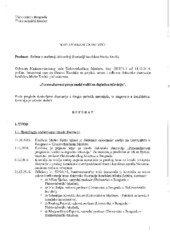Prikaz osnovnih podataka o disertaciji
Personalizovani programski vodiči za digitalnu televiziju
Personalized program guides for digital television.
| dc.contributor.advisor | Bjelica, Milan | |
| dc.contributor.other | Čeperić, Vladimir | |
| dc.contributor.other | Simić-Pejović, Mirjana | |
| dc.creator | Krstić, Marko Ž. | |
| dc.date.accessioned | 2019-07-31T14:32:32Z | |
| dc.date.available | 2019-07-31T14:32:32Z | |
| dc.date.available | 2020-07-03T08:36:27Z | |
| dc.date.issued | 2019-04-18 | |
| dc.identifier.uri | https://nardus.mpn.gov.rs/handle/123456789/11290 | |
| dc.identifier.uri | http://eteze.bg.ac.rs/application/showtheses?thesesId=6825 | |
| dc.identifier.uri | https://fedorabg.bg.ac.rs/fedora/get/o:19921/bdef:Content/download | |
| dc.identifier.uri | http://vbs.rs/scripts/cobiss?command=DISPLAY&base=70036&RID=51493135 | |
| dc.description.abstract | Razvoj digitalne televizije je doveo do značajnog porasta broja TV sadržaja dostupnih korisnicima, ali je otežao izbor onog koji je od interesa. Sve do pojave personalizovanih programskih vodiča sposobnih da nauče korisnička interesovanja i preporuče odgovarajuće sadržaje nije postojalo rešenje koje je na adekvatan način razmatralo ovaj problem. Ranija rešenja, kao što su štampani i elektronski vodiči, su pretežno samo pretvarala problem viška informacija u drugi oblik. Napredak tehnologije i društva postavlja sve veće zahteve pred personalizovane programske vodiče za digitalnu televiziju, što zahteva njihovo pažljivo planiranje i projektovanje. Vodiči moraju da budu u mogućnosti da modeliraju različite načine donošenja odluka pojedinačnih korisnika, da rade u realnom vremenu na mobilnim uređajima s ograničenim hardverskim resursima, da vode računa o karakteristikama prikupljenih podataka, da uzimaju u obzir kontekst u kome se pristupa TV sadržaju i da štite privatnost svih korisnika, jer neki od njih nisu svesni mogućih opasnosti. Pažljivim izborom arhitekture i algoritma učenja, lokalno implementiran vodič baziran na neuralnim mrežama može da ispuni sve ove zahteve. S obzirom na to da korisnici znatno češće pružaju informacije o sadržajima koji im se dopadaju nego o onim koji im se ne dopadaju, u ekstremnim slučajevima se dešava to da su prikupljene samo pozitivne interakcije. Da bi se taj problem prevazišao, predložen je sistem s dva režima rada. U prvom režimu sistem uči i pruža preporuke samo na osnovu TV sadržaja koje korisnik voli, dok u drugom izjednačava uticaj sadržaja koje korisnik voli i onih koje ne voli na proces pružanja preporuka. Povećan uticaj pozitivnih interakcija dovodi do degradacije predikcije sadržaja koje posmatrač ne želi da gleda, te će se, usled greške u klasifikaciji, neželjeni sadržaji često pojavljivati u listi preporuka i na taj način smanjiti zadovoljstvo korisnika. Korišćenjem serije simulacija pokazali smo da je postignuto trajanje treniranja neuralne mreže kratko, čak i na uređajima s ograničenim hardverskim resursima. Zaključak je da je predloženi vodič veoma pogodan za implementaciju na mobilnim uređajima od kojih se očekuje da u budućnosti postanu dominantan način pristupa TV sadržajima. | sr |
| dc.description.abstract | The development of digital television significantly increased the quantity of media contents available to the users, but made it difficult to make the right choice. Before the invention of the personalized program guides capable of learning user preferences and recommending adequate contents, there were no means of properly addressing this problem. Former solutions, such as printed or electronic program guides, mostly converted the problem of having to deal with too much information into another form. The advancements in both technology and society put higher demands to the personalized program guides for digital TV, which require careful planning and design processes. Guides must be able to model various individual decision making approaches, work in real-time on mobile devices with limited hardware resources, take into account the characteristics of the collected data, take into consideration the program accessing context and protect the privacy of all users, since some of them are not aware of the possible risks. By carefully choosing the architecture and learning algorithms, a locally implemented guide based on neural networks can fulfil all the aforementioned requirements. Due to the fact that the users provide information about the content they like much more often than about the one they dislike, only positive interactions are collected in extreme cases. In order to overcome that situation, a system having two operating modes is proposed. The first mode enables the system to learn and give recommendations based on preferred TV contents, while the second equalizes the influence of the liked and disliked contents on the recommending process. The increased influence of positive interactions degrades the unwanted content prediction process, resulting in classification error, appearance of unwanted content in the recommendation list and user dissatisfaction. By applying a series of simulations, we showed the accomplished neural network training time to be short, even in cases of devices with limited hardware resources. It can be concluded that the proposed guide is very convenient for implementation on mobile devices which are expected to become a dominant way of accessing media contents in the future. | en |
| dc.format | application/pdf | |
| dc.language | sr | |
| dc.publisher | Универзитет у Београду, Електротехнички факултет | sr |
| dc.relation | info:eu-repo/grantAgreement/EC/FP7/619241/EU// | |
| dc.rights | openAccess | en |
| dc.rights.uri | https://creativecommons.org/licenses/by-nc-nd/4.0/ | |
| dc.source | Универзитет у Београду | sr |
| dc.subject | digitalna televizija | sr |
| dc.subject | digital television | en |
| dc.subject | recommender systems | en |
| dc.subject | neural networks | en |
| dc.subject | privacy protection | en |
| dc.subject | class imbalance | en |
| dc.subject | preporučivači | sr |
| dc.subject | neuralne mreže | sr |
| dc.subject | zaštita privatnosti | sr |
| dc.subject | disbalans klasa | sr |
| dc.title | Personalizovani programski vodiči za digitalnu televiziju | sr |
| dc.title.alternative | Personalized program guides for digital television. | en |
| dc.type | doctoralThesis | en |
| dc.rights.license | BY-NC-ND | |
| dc.identifier.fulltext | http://nardus.mpn.gov.rs/bitstream/id/5935/IzvestajKomisije20707.pdf | |
| dc.identifier.fulltext | https://nardus.mpn.gov.rs/bitstream/id/5935/IzvestajKomisije20707.pdf | |
| dc.identifier.fulltext | https://nardus.mpn.gov.rs/bitstream/id/5934/Disertacija.pdf | |
| dc.identifier.fulltext | http://nardus.mpn.gov.rs/bitstream/id/5934/Disertacija.pdf | |
| dc.identifier.rcub | https://hdl.handle.net/21.15107/rcub_nardus_11290 |



